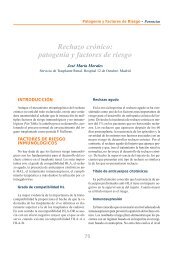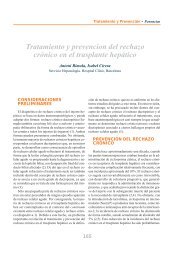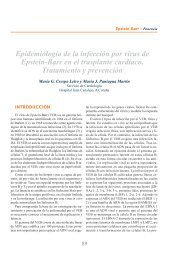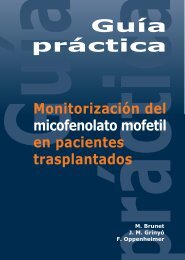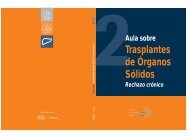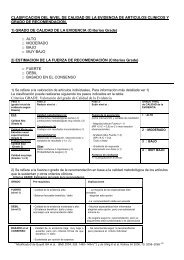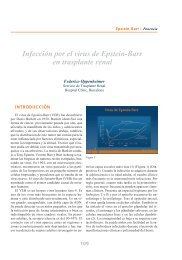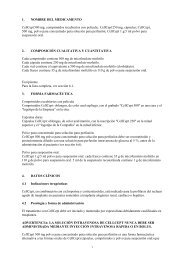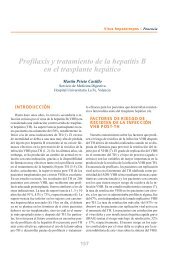Untitled - Roche Trasplantes
Untitled - Roche Trasplantes
Untitled - Roche Trasplantes
Create successful ePaper yourself
Turn your PDF publications into a flip-book with our unique Google optimized e-Paper software.
BIOPSIA DE PROTOCOLO EN EL TRASPLANTE RENAL<br />
IMMUNOLOGICAL MECHANISMS OF HUMORAL<br />
REJECTION AFTER ORGAN TRANSPLANTATION<br />
The pathogenesis of hyperacute and acute humoral rejection is based on complement<br />
fixation by antibodies. Antibody-mediated complement activation in humoral rejection<br />
follows the classical pathway. Complement component C1 is activated by the interaction<br />
of IgG or IgM with C1q bound to antigen epitopes on the graft endothelium.<br />
Conformational changes in C1q then allows cleavage of C1r, and activated C1r cleaves<br />
and activates C1s, which is the enzyme that activates C2 and C4. C4 is cleaved by C1s<br />
into the small fragment C4a and the large fragment C4b. After inactivation of C4b to C4d<br />
by factor I, C4d remains covalently bound to the tissue by a thioester group at the site<br />
where it was degraded. So far, no reports indicate that C4d has here any functional activity;<br />
nevertheless, this makes C4d to a durable in situ marker of complement activation.<br />
(Complement activation in transplants is reviewed in detail in) After complement<br />
activation at the endothelium in the microcirculation of allografts (i.e., peritubular and<br />
glomerular capillaries in renal allografts) C4d can be detected by immunohistochemistry<br />
or immunofluorescence using anti C4d antibodies. C4d co-distributes with type IV collagen<br />
along the capillary basement membrane and the endothelial cell surfaces. From<br />
this localization, C4d can be cleared, after the antibody response has ended. Disappearance<br />
of C4d has been described as early as 8 days after treatment.<br />
C4b combines with C2a and forms C4b-C2a, which is known as the classical-pathway C3<br />
convertase activating C3 by cleavage to C3a and C3b. When a C3b molecule is covalently<br />
deposited in the immediate vicinity of the C3 convertase, the C5 convertase –C4b-C2a-<br />
C3b– forms. Cleavage of C5 then releases C5a, and C5b. C5b initiates formation of the<br />
Membrane-Attack-Complex (MAC C5b-C9) which finally causes cell lysis and death.<br />
Furthermore, complement activation mediates acute graft injury by attracting inflammatory<br />
cells like neutrophils and macrophages via the chemoattractants C3a and C5a and simultaneously<br />
leads to endothelial cell activation with an increased production of pro-inflammatory<br />
molecules (e.g., cytokines, chemokines, adhesion molecules, growth factors).<br />
For allograft injury the activation and regulation of the steps of the complement cascade<br />
after C4 are crucial. If activation would stop at C4 (i.e. C4d already detectable in the allograft)<br />
without activation of C3 (i.e., no C3d in the allograft), then allograft injury might<br />
be prevented or at least reduced.<br />
DIAGNOSIS OF ACUTE HUMORAL REJECTION<br />
AFTER RENAL TRANSPLANTATION<br />
A recent up-date of the international Banff classification system for renal allograft pathology<br />
defines the entity of acute humoral rejection (AHR) and provides the following four<br />
diagnostic criteria:<br />
52




